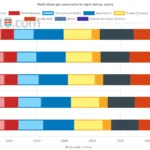Original Report: energynews.pro(full story)
- The UN’s Supervisory Body has approved standards for carbon project methodologies and removals under Article 6.4 of the Paris Agreement.
- This marks a significant advancement towards establishing a global carbon market and the operationalization of carbon crediting mechanisms.
The United Nations entity responsible for establishing guidelines for a global carbon market under Article 6.4 of the Paris Agreement has made unprecedented strides by finalizing standards for project methodologies and carbon removals. This development was approved during the recent meeting held in Baku, culminating on October 9.
The Supervisory Body (SBM) opted to create these standards rather than merely submit recommendations for endorsement at the forthcoming COP29, thereby facilitating the swift operationalization of this crucial carbon crediting mechanism. “The standardization adopted is essential for making the mechanism fully operational,” stated the body on October 10.
Article 6.4 permits a company in one country to account for domestic emissions reductions by selling credits to firms in another country, thus creating a structured global carbon market with a heightened demand for carbon credits. With the UN laying down eligibility parameters, the path ahead appears more defined.
Despite previous negotiations to activate Article 6.4 being fraught with challenges due to integrity issues and methodological concerns, the SBM’s establishment of standards signifies a significant evolution in this domain. Industry analysts, such as Andrea Bonzanni from the International Emissions Trading Association, noted that the streamlined approach would facilitate approvals at COP29 and allow for adaptive standard updates.
“The SBM and its members are tasked with a mandate from the CMA and must uphold it. If the SBM’s decisions are constantly renegotiated, we risk an ineffective credit mechanism,” she warned.
With these standards now published, project developers can submit methodologies for review by the Methodology Expert Panel under SBM supervision. According to Dana Agrotti, lead carbon analyst at S&P Global Commodity Insights, these standards enable the design of methodologies for removal activities by both SBM and private developers.
As a consequence, voluntary carbon market methodologies adhering to these standards could yield Article 6.4 eligible units, contingent upon progress in negotiations. This move could facilitate an influx of engineered removal credits, especially those validated through government-sanctioned adjustments.
The development, however, follows protracted negotiations concerning the criteria for carbon projects within this framework, often bogged down by integrity-related disputes. The SBM has committed to a thorough and timely approach to refine the standards and provide a report on advancements in methodology implementation to the CMA as part of its annual assessment.
Article 6 of the Paris Agreement delineates the protocols for the exchange of greenhouse gas emissions reductions on a global scale, with Article 6.2 establishing a national accounting system for GHG emissions that permits cross-border credit exchanges. The valuation of carbon credits, varying from $4.55 to $140 per ton, reflects the diverse nature of carbon funding projects.







